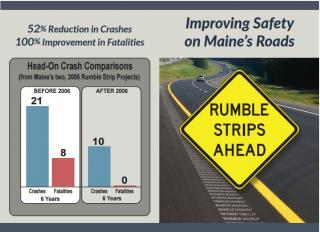Understanding Rumble Strips

On Maine’s rural roads, many crashes and MOST fatalities (70% of the total) result when a vehicle leaves its designated travel lane (going either left or right) and is involved in a Lane Departure crash. That crash may be further described either as a Went Off Road or a Head On type crash. Although far fewer Head On crashes occur compared to the number of Went Off Road crashes, the likelihood of a serious injury or a fatality in a Head On crash are very high. In Maine, during the past 10 years, there have been over 8,000 Head On crashes and those resulted in 355 fatalities and more than 1,100 serious injuries. In recent years, there has been an average of 33 Head On fatalities occurring annually. That number spiked up in 2014 to 46, but was back down to 30 in 2015.
Vehicles leave their proper lane due to a variety of driver contributing factors: speed, alcohol/drugs, distracted driving, fatigue/falling asleep, medical episodes… also wintry or wet roads contribute to some incidents.
Preventing deadly Head On crashes has been a continuing focus for MaineDOT. Center line rumble strips have been found to be the best mitigation to prevent these crashes. Rumble strips provide immediate feedback to the driver at that point of lane deviation and are intended to alert that driver to correct course. While smart cars are coming onto the market, and some new cars feature lane departure alert systems, it will still be a long time before all vehicles become interactive with the driver or self-correcting when things go wrong. Rumble Strips have been a proven way to alert erring drivers that they are leaving their lane – regardless of any available on-board vehicle technology.
Read more, including before/after rumble strip installation incident statistics and what is planned for 2017 and beyond in MaineDOT's brochure, Understanding Rumble Strips, or the publication Safety Performance on Maine’s Rumble Strip Corridors.
